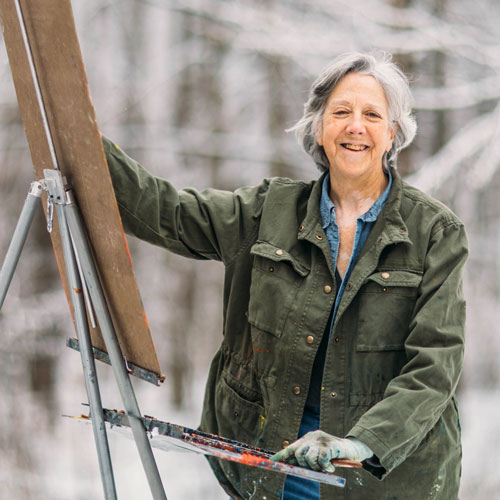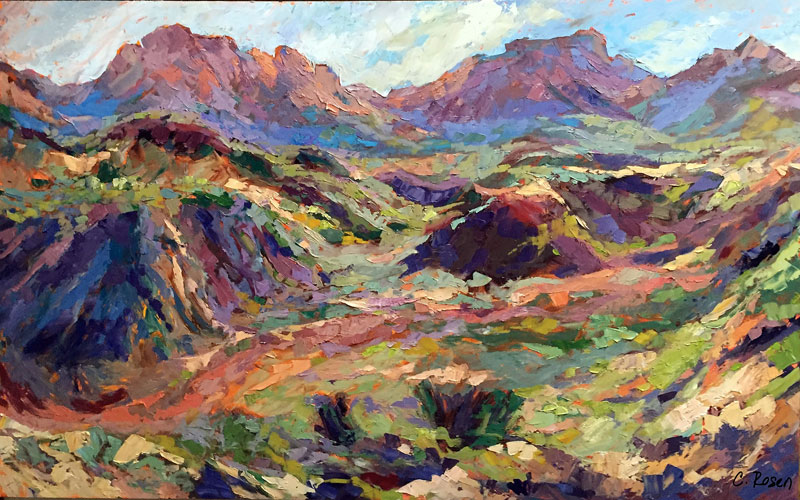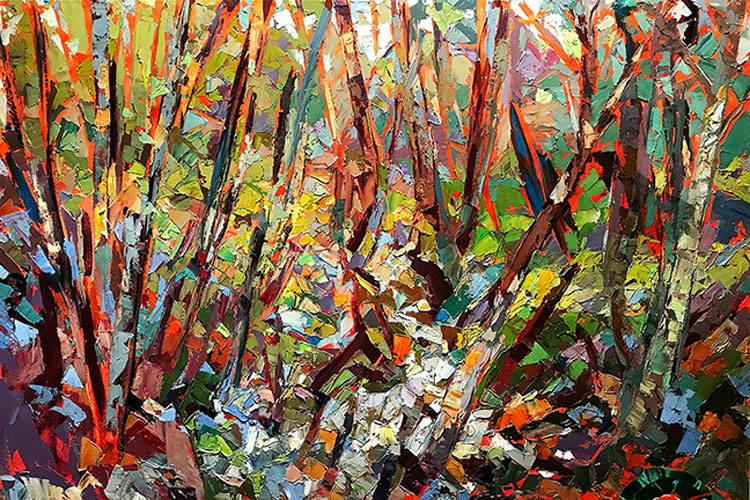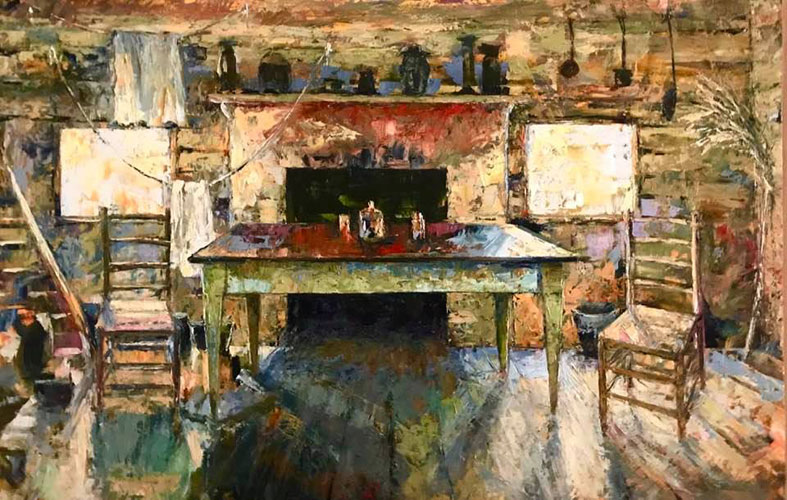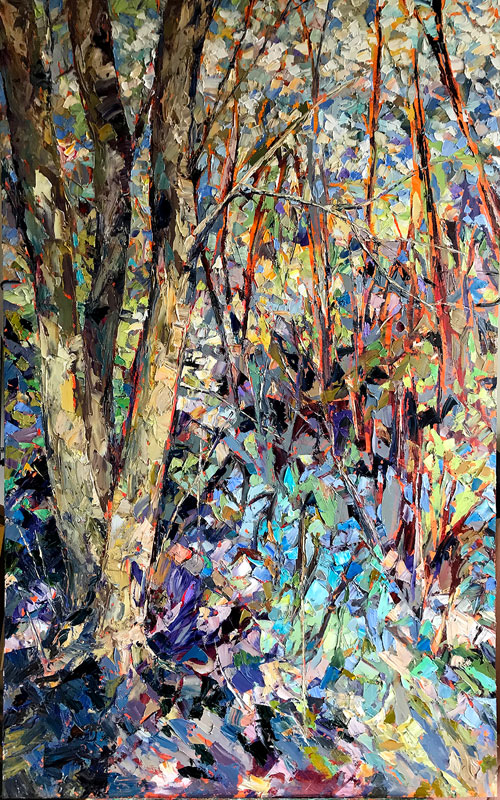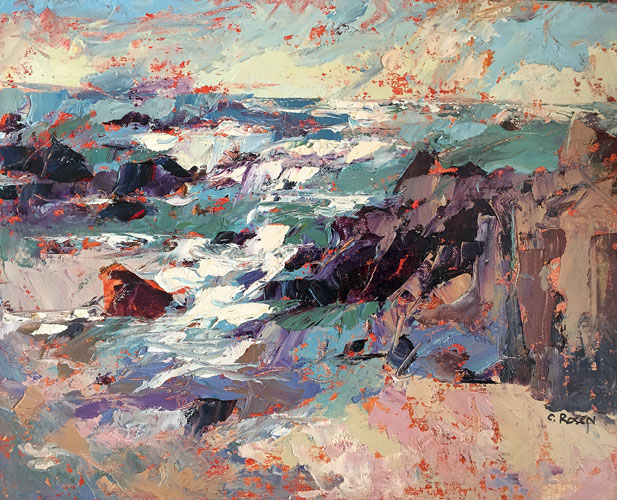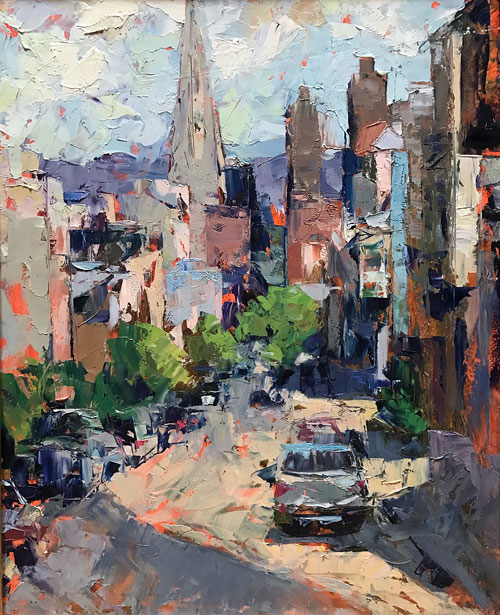Art, // May 9, 2020
Cynthia Rosen — ARTIST
Interview with the artist Cynthia Rosen —
1. Who are you and what do you do?
I am a painter, primarily plein air, though as part of the creative process, change is both the path to growth as well as perhaps the most interesting part of being an artist. I have a reputation for being a palette knife painter using strong colors and dancing on the line between abstraction and expressionism. While plein air usually implies smaller works, I prefer to paint large. And rather than depicting a scene I use the sight as a jumping off point for exploring the dynamics it portrays as well as the movement within in an attempt to capture the affect of time.
2. Why art?
Why art is an amazing question in fact. Prosperity is great, technological innovation as well, medical advances help our physical health, religion helps raise our spiritual awareness, but art feeds the soul and helps in both the bonding and understandings between people.
It is a common visual language that transcends spoken language and many cultural divides. It expresses much about human understandings, provides ideals through beautify, reflects societal changes and challenges perceptions, and at times generates new ideas and understandings. But for me, the most important aspect is that the arts, be it music, theater, dance, literature or the visual, bond people while providing the individual with a great sense and understanding of oneself and elevates us as a species.
3. What is your earliest memory of wanting to be an artist?
I actually did not really discover the visual arts until high school. I guess I did well in Jr High as I received the art award, but was unaware at the time of any particular ability or interest. It was not something my home reinforced. In high school, particularly in 11th and 12th grades, I could take art daily and discovered that not only did I enjoy making art but I had an eye/hand coordination that allowed me to readily draw what I saw. It was really in 12th grade that I decided that I wanted to just paint.
4. What are your favorite subject(s) and media(s)?
Painting outside in oils is my favorite place to make art and has provides enough fodder to last my lifetime plus. I love the movement in landscapes. that is: nature scenes. I adore painting a rocky coast and particularly turquoise waters, but living in a landlocked state, I rarely find that accessible. The palette knife is not great for working on detailed architectural subjects and unless i am combining it with brushwork, and it is not great for complex city images on a surface smaller than 18×24.
But, I am not limited in interest to landscapes. I do enjoy still lifes and am presently starting a figurative series. I would like to make art that has some social relevance. Additionally I am in the process of pursuing a mixed medium abstract series.
Regarding medium, with the exception of cold wax, I have not met a medium I don’t like. They all have great value for their individual characteristics and qualities. The only issue is I that I don’t like to deal with glass and as I travel a fair amount to paint, it limits what medium works best. Additionally I do like to work large which makes glass even more problematic. That is why I mostly stick to oils. Oils are also easy to work with in a variety of weather conditions and I have created an easel that will work for large or small works. If more time and energy allowed for it, I would travel with a huge variety of supplies and be able to pull any medium on that given day, as long as I am not at a plein air event and having to worry about framing on site.
5. How do you work and approach your subject?
When painting plein air I look for sights that are both interesting and safe, particularly if painting alone. Ideally, earlier or later in the day when the shadows are more interesting. That is also weather dependent. If it is high noon, I prefer to be in the woods, where I still find scattered light. When painting outside, I will often paint 2 paintings simultaneously if the longer side is 20 inches or less and do not have to worry about time restraints. Since i have made the effort to find a site and haul my gear, there is usually more than one view that attracts me. Painting two at a time allows me to work on both views as well as lets one painting breathe, so to speak. while working on or troubleshooting the other one.
If in the studio, I often procrastinate (chuckle). Usually if I am not procrastinating in the studio it is because I am in need of a big color boost which means working on a floral still life or a commission. In the studio I always have several works on easels because part of the process involves problem solving. Time and repeated opportunities to look at a painting, when not directly applying paint, often allows us to see issues that may not be immediately evident while actively painting and troubleshoot any problems that exists.
Regarding my process, I almost always stain my surface with a warm tone. Usually orange (ranging from red to orange). Occasionally I throw in some purple or blue. I brush the color on roughly, and then using a brush quickly block in the basic composition. Being a knife painter, I then start to paint the painting with a palette knife. I like the way the orange colors work against my cool tones (mostly blues and greens) adding a touch of excitement. Painting with the knife, the way I paint, is a slower process than working with a brush on a large surface, but it is also nice to work more solvent free since I apply thicker paint and I don’t have to clean brushes.
6. What are your favorite art work(s), artist(s)?
My favorite painter for most of my life is and has been Mark Rothko. I also am incredibly fond of Thomas Hart Benton’s work as I love how he imbues life into his images. I also love Pierre Bonnard, Édouard Vuillard, the collages of Robert Rauschenberg, the drawings of Jim Dine, the order and sensitivity of William Bailey, and the geometric strength of Richard Diebenkorn. One could say I am a bit obsessed with movement. It connects to my fascination with the impact of time. I like the Color Field painters and yet surprisingly love the romance of works by William-Adolphe Bouguereau, John William Waterhouse, and Joaquín Sorolla, and ironically the bold colors of the Expressionists. I like the repetition of form in the works of the cubists and futurists, the paint quality of Nicolai Fechin, and finally the Russian impressionists are amazing. And the freedom of thought gifted by Picasso.
7. What are the best responses you have had to your work?
Having spent much of my professional life as a teacher, I love it when people find that my art “inspires them and frees them to pursue their own voice. I am on cloud nine when my colors excite people, and that is the most common response people have to my work. It has taken a while for the plein air community to accept artwork that is non-traditional. I know many people still don’t accept it, but that is okay. Different strokes for different folks. But enough people have begun to make way towards accepting a stylistic differences and buyers love my colors, so I have been able to earn a living. (though Covid-19 has had a devastating affect…so we will see).
8. What do you like about your work?
What I like most about my work is perhaps the fact that I am rarely happy with it. As odd as that sounds, it is what drives me to keep working. And I am ecstatic that there is so much I want to do and try, that I will never tire of it. I may be tired from it, but not of it.
9. What advice would you give to other artists?
People should know, if they are wanting to make art professionally, that unless they have a financial angel or a partner ready, willing and able to deal with the business end of their career, they should expect to spend only half of their time making art and the rest of the time dealing with business. If I could make art all of the time, it would be glorious. I don’t actually like the business end, but I don’t have any options but to do it myself.
For young artists, realize that it is a way of life. I could not be a painter and be the kind of parent I deeply wanted to be. So I had to return to making art later in life after giving it up for years. If you want a family, you need to have a partner who is deeply interested in parenting, or become a more commercial artist while raising children. Some of the best painters I know were illustrators while their children were growing up and moved into the fine art field afterwards (and I am not saying one is exclusive of the other…it is just where your income comes from).
My other advice is to follow your heart, BUT, get your basic skills (learn how to draw) if you have not already done so. Art is actually very complex and you get out what you put in. Do not give up but rather find a good teacher or a good path to learn what you need. Aim for quality, do not be content with mediocrity, but know that the vast majority of what you produce will just be stepping stones towards getting better. We don’t really make final products in and for themselves. Rather they are mini challenges or opportunities to learn.
And finally, we are blessed to live in an era and in a society which accepts different kinds of art, so allow yourself to take advantage of that freedom and find your personal voice.
10. Where do you see yourself in 5-10 years?
I will surely continue to pursue my path, and of course am hoping to see continued success and contentment. I would like to see my figurative series running smoothly and be working on really large works. I will also be using a wider variety of tools. I love the palette knife but really spent time this past year testing and learning of it’s limitations.
The present pandemic is going to hurt the art market as it has negatively impacted so many parts of our society, but I will keep making art and working with people to help them find their personal creative paths. I love teaching and firmly believe I am a better teacher than a painter. My greatest gift is helping people find discover their own talents and how to learn from that very particular ability of theirs. So I will continue giving workshops and teaching.
LINKS —
Website: https://www.cynthiarosen.com
Facebook: https://www.facebook.com/cynthiarosen.art
instagram: https://www.instagram.com/rosencynthia/
Streamline Art Video: https://streamlineartvideo.com/collections/all/products/cynthia-rosen-expressive-landscape-painting-palette-knife-in-plein-air
U-tube:
https://www.youtube.com/watch?v=BUAich-w0zA (from Streamline so starts with an advertisement)
https://www.youtube.com/playlist?list=PLoQfWI2OjxDFKisPfNJ9vPW0hMJfSKJNL
https://www.youtube.com/watch?v=tb6aQPbQR9g&list=PLoQfWI2OjxDFKisPfNJ9vPW0hMJfSKJNL&index=4
Vimeo:
https://vimeo.com/247807066
Recent Magazine Articles:
Plein Air Magazine articles – Pushing Boundaries: https://www.dropbox.com/s/bhamz8416a25xea/PADecJan2019_106-113.pdf?dl=0
Cynthia Rosen – Asserting Your Own Voice as a Plein Air Painter:
https://www.outdoorpainter.com/asserting-your-own-voice-plein-air-painting/
Southwest Art – Life In Motion: https://www.southwestart.com/featured/rosen-c-jul2018
The Artists Road: https://www.theartistsroad.net/articles/cynthiaroseninterview



